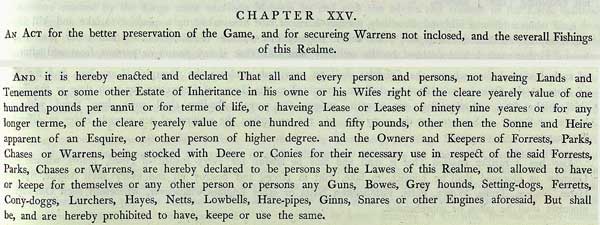Lecture 9 outline February 11, 2005
Medieval hunting and the game laws, continued
______________________________________________________
Announcements:
(1) Reminder Bambi film next week, Tuesday and Thursday evenings: Fernow 14, 7:30 pm
(2) All readings next week on e-reserve.
(3) Two handouts today: Blackstone, Renaissance
________________________________________________
I. Gaston’s Livre de chasse
Why do these books exist?
Gaston: “Father of the Year”?
Other versions of the book:
Edward of Norris (circa 1407), Master of Game
The Book of St. Albans, printed in English in 1486
Later hunting manuals and the shift in appeal to the growing middle class and to merchants
Thomas Cockaine, A Short Treatise on Hunting (1591), available in full text on the web at http://darkwing.uoregon.edu/~rbear/hunting/cockaine.html
Jean Cocteau’s 1946 film and Avenant as a possible prototype for Disney's Gaston? See e.g., Professor Wally Hastings’s website about Beauty and the Beast, http://www.northern.edu/hastingw/beautybeast.htm
II. The hunt, medieval game laws, and the invention of capitalism
Game laws include:
• Game Law of 1389-90
• Game Act of 1485
• 1539-40 capital game offenses
• Game Act of 1580-81
Later game laws included:
• Game Laws of 1671
• Waltham Black Acts of 1722
Michael Perelman’s analysis:
Perelman, Michael. The Invention of Capitalism: Classical Political Economy and the Secret History of Primitive Accumulation (Durham: Duke University Press, 2000). See Chapter 3, “Primitive Accumulation and the Game Laws.”
Perelman asks: Why did the feudal Game Laws become so much harsher under capitalism?
[SLIDE: TEXT OF ACT OF 1671]

“Meat virtually disappeared from the tables of the rural poor,’” Perelman writes.
ADDITIONAL SUGGESTED READING:
Munsche, P. B. Gentlemen and Poachers : The English Game Laws, 1671-1831 (New York: Cambridge University Press, 1981), and
Landry, Donna. The Invention of the Countryside: Hunting, Walking, and Ecology in English Literature, 1671-1831 (NY: Palgrave Macmillan, 2001).
III. The Hunt and Renaissance Art
[SLIDE: BRUEGEL, VERMEER, DÜRER]
A. Pieter Bruegel the Elder
[SLIDE]:
Pieter Brueghel, Hunters in the Snow (1565)
Oil on canvas, 46 inches x 63.75 inches.
Kunsthistorisches Museum, Vienna.
The Hunter in the Snow
William Carlos Williams
The over-all picture is winter
icy mountains
in the background the return
from the hunt it is toward evening
from the left
sturdy hunters lead in
their pack the inn-sign
hanging from a
broken hinge is a stag a crucifix
between his antlers the cold
inn yard is
deserted but for a huge bonfire
that flares wind-driven tended by
women who cluster
about it to the right beyond
the hill is a pattern of skaters
Brueghel the painter
concerned with it all has chosen
a winter-struck bush for his
foreground to
complete the picture
[SLIDES}:
Winter Landscape with Bird Trap